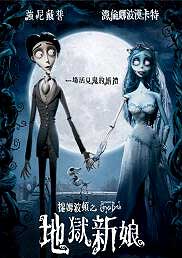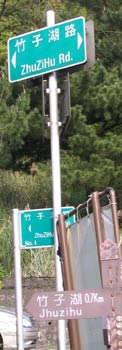Speaking yesterday on topics related to signage and romanization, Taipei County Magistrate Zhou Xi-wei said that Taipei County should have its systems match those of Taipei City:
Táiběi Xiànzhǎng Zhōu Xīwěi xīwàng yǐ shēnghuóquān wéi kǎoliáng, yào hé Táiběi Shì zhěnghé yīzhì.
One of the implications of this is that for Taipei County, Taiwan’s most populous area, Tongyong Pinyin is out and Hanyu Pinyin is in.
This is no surprise, given that Zhou
- is a member of the Kuomintang, whose chairman, Ma Ying-jeou, has backed Hanyu Pinyin and implemented it in Taipei in his role as mayor of the capital
- campaigned for integration (whatever that’s supposed to mean) of Taipei County with Taipei City.
As an advocate of Hanyu Pinyin and resident of Taipei County, I’m pleased by the change. But as someone who has lived in Taiwan for ten years, I know all too well how likely it is that the new signage will be botched. Taiwan has a poor record of correct implementation of romanization — in any system. Moreover, there are aspects of Taipei City’s signage that Taipei County should certainly not copy, namely InTerCaPiTaLiZaTion (unnecessary and counterproductive) and “nicknumbering” (putting a number on a street does nothing to aid communication if nobody knows what the number refers to). So if this doesn’t end up another SNAFU, I’ll be pleasantly surprised. (Does anyone have any good contacts within the Taipei County government? I’d like to be able to talk with some people in charge well before this gets beyond the planning stage.)
Until late last year Taipei County was under a DPP administration, so its romanization policy, such as it was, was to use Tongyong Pinyin. But implementation has been spotty and often sloppy. Most street signs in Taipei County remain in MPS2. Banqiao has seen more signs in Tongyong Pinyin; but most of those have the romanization in such relatively tiny letters that it’s nearly useless for drivers.
Turning back for a moment to the news reports that prompted this post, an additional item of interest is the headline of one of the stories: Pīnyīn fāngshì「qiao」bùdìng Yīngwén dìmíng busasa (拼音方式「喬」不定 英文地名霧煞煞). Here, both qiao and busasa are Taiwanese, not Mandarin. (A-giâu or somebody else, help me out on the spelling here!)
Here’s one of the stories:
Táiběi jiéyùn Bǎnqiáo-Tǔchéng xiàn jiāng yú wǔ yuèfèn tōngchē zhì Tǔchéng yǒng nìng zhàn, yīnyīng zhuǎnchéng lǚkè xūyào, Tái-Tiě Bǎnqiáo chēzhàn jiāng shèzhì línshíxìng zhǐshì pái. Bùguò, Yīngyǔ yìyīn hùnluàn, xiànzhǎng Zhōu Xī-wěi biǎoshì, gāi cǎiyòng Tōngyòng Pīnyīn huòshì Hànyǔ Pīnyīn, jiāng huì yǐ shēnghuóquān de gàiniàn wèi qiántí, yǔ Táiběi Shì zhěnghé.
So the additional MRT stations are opening in May after all. As a Banqiao resident who has waited long for that day, I’m happy to hear it. But since the stations are opening so soon, I’d be willing to bet that they’ll reproduce the mistakes already in the system instead of correcting them.
Zhōu Xī-wěi biǎoshì, wèilái yě jiāng tuīdòng yī piào fúwù dàodǐ wèi mùbiāo, rú mínzhòng chíyǒu yōu yóu kǎ huò qítā piàozhèng, jíkě zhuǎnchéng jiéyùn, gāo tiě huò Tái-Tiě, dāchéng dàzhòng yùnshū gōngjù jiāng gèng biànlì.
Zhōu Xī-wěi jīntiān xiàwǔ xúnshì Bǎnqiáo huǒchēzhàn rénxíng tōngdào, duìyú Tái-Tiě, gāo tiě jí jiéyùn sān tiě gòng gòu, zhàn pái, lù míng Yīngwén biāoshì què wǔhuābāmén, yǒude yòng Táiwān Tōngyòng Pīnyīn, yǒude yǐ Zhōngguó dàlù Hànyǔ Pīnyīn, érqiě biāoshì shífēn bù míngxiǎn, dēngguāng bùgòu míngliàng, Zhōu Xī-wěi xīwàng gè dānwèi xiétiáo gǎishàn.
Zhōu Xī-wěi rènwéi, Bǎnqiáo chēzhàn jiānglái shì quánguó zuìdà de jiāotōng zhuǎnyùnzhàn, měirì fúwù wúshù mínzhòng, biāoshì yīng yǐ jiǎndān fāngshì, qīngchu gàosu shǐyòng rénshēn yú héchù, gāi wǎng héchù qù.
sources:
- Tái-Tiě Bǎnqiáo chēzhàn Yīngwén yìyīn língluàn — Zhōu Xīwěi [hū]yù gǎijìn, CNA, March 27, 2006
- Pīnyīn fāngshì「qiao」bùdìng Yīngwén dìmíng busasa (拼音方式「喬」不定 英文地名霧煞煞), March 27, 2006

 The cover for the DVD for Tim Burton’s Corpse Bride (Dìyù Xīnniáng / 地獄新娘 / “Hell Bride”) has what for me is an arresting usage: the roman letter “e” has been incorporated into a Chinese character.
The cover for the DVD for Tim Burton’s Corpse Bride (Dìyù Xīnniáng / 地獄新娘 / “Hell Bride”) has what for me is an arresting usage: the roman letter “e” has been incorporated into a Chinese character.![Tim Burton's ['Corpse Bride'] -- in Chinese characters](https://pinyin.info/news/news_photos/2006/03/corpse_bride.gif)

 Less than 10 years ago the romanization on Taipei’s street signs was a complete mess. The “standard,” such as it was, was the inherently bad
Less than 10 years ago the romanization on Taipei’s street signs was a complete mess. The “standard,” such as it was, was the inherently bad  The reason for the different spellings here is almost certainly that the road, being within Taipei, is labeled in Hanyu Pinyin, whereas the trail marker, for a trail within Yangming Shan National Park, was put up by the central government and is thus in Tongyong Pinyin — well, almost. The misspelled Tongyong in the sign isn’t just a one-off, either. All of the Tongyong-ish signs I saw in the area are misspelled in the same way. See, for example, the sign at right. (The arrows, by the way, are both correct: The road is a loop.)
The reason for the different spellings here is almost certainly that the road, being within Taipei, is labeled in Hanyu Pinyin, whereas the trail marker, for a trail within Yangming Shan National Park, was put up by the central government and is thus in Tongyong Pinyin — well, almost. The misspelled Tongyong in the sign isn’t just a one-off, either. All of the Tongyong-ish signs I saw in the area are misspelled in the same way. See, for example, the sign at right. (The arrows, by the way, are both correct: The road is a loop.)  Closer examination, however, reveals that Zhuzihu is based upon a bisyllabic name after all. Zhuzi Hu means “Bamboo Lake” (Zhúzi Hú / 竹子湖). The only particular reason for writing it solid (Zhuzihu) rather than as “Zhuzi Hu” is that there’s no actual hu (lake) there anymore. (It was more like a marsh, anyway.) Come to think of it, I don’t remember seeing any bamboo there, either. A case could be made for writing it either way: Zhuzi Hu or Zhuzihu
Closer examination, however, reveals that Zhuzihu is based upon a bisyllabic name after all. Zhuzi Hu means “Bamboo Lake” (Zhúzi Hú / 竹子湖). The only particular reason for writing it solid (Zhuzihu) rather than as “Zhuzi Hu” is that there’s no actual hu (lake) there anymore. (It was more like a marsh, anyway.) Come to think of it, I don’t remember seeing any bamboo there, either. A case could be made for writing it either way: Zhuzi Hu or Zhuzihu